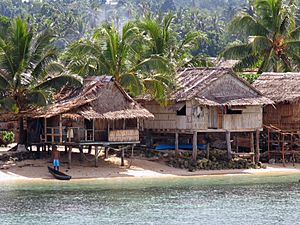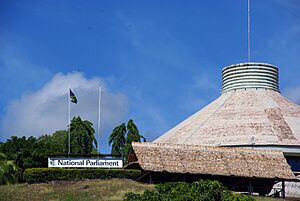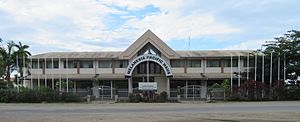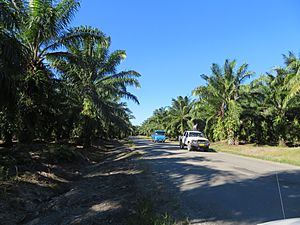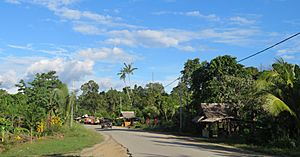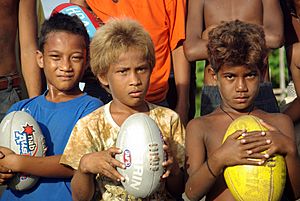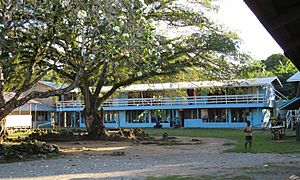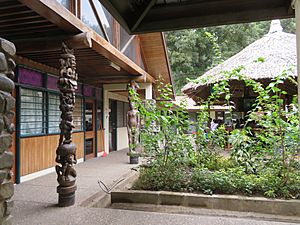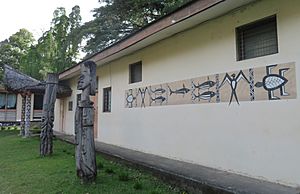Solomon Islands facts for kids
Quick facts for kids
Solomon Islands
Solomon Aelan (Pijin)
|
|
|---|---|
|
|
|
|
Motto: "To Lead is to Serve"
|
|
|
Anthem: "God Save Our Solomon Islands"
|
|
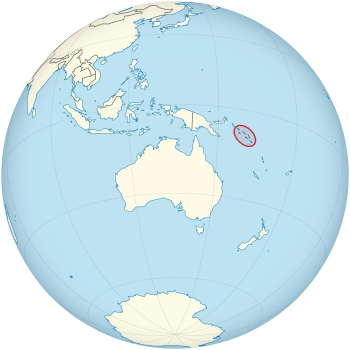 |
|
| Capital and largest city
|
Honiara 9°25′55″S 159°57′20″E / 9.43194°S 159.95556°E |
| Official languages |
|
| Ethnic groups
(2016)
|
|
| Religion
(2016)
|
|
| Demonym(s) | Solomon Islander Solomonese |
| Government | Unitary parliamentary constitutional monarchy |
|
• Monarch
|
Charles III |
| David Tiva Kapu | |
| Jeremiah Manele | |
| Legislature | National Parliament |
| Independence | |
|
• from the United Kingdom
|
7 July 1978 |
| Area | |
|
• Total
|
28,896 km2 (11,157 sq mi) (139th) |
|
• Water (%)
|
3.2% |
| Population | |
|
• 2023 estimate
|
734,887 (167th) |
|
• 2019 census
|
721,956 |
|
• Density
|
24.2/km2 (62.7/sq mi) (200th) |
| GDP (PPP) | 2024 estimate |
|
• Total
|
|
|
• Per capita
|
|
| GDP (nominal) | 2024 estimate |
|
• Total
|
|
|
• Per capita
|
|
| Gini (2013) | medium |
| HDI (2022) | medium · 156th |
| Currency | Solomon Islands dollar (SBD) |
| Time zone | UTC+11 (Solomon Islands Time) |
|
• Summer (DST)
|
Solomon Islands does not have an associated daylight saving time |
| Driving side | left |
| Calling code | +677 |
| ISO 3166 code | SB |
| Internet TLD | .sb |
The Solomon Islands is an island country in Oceania. It is located east of Papua New Guinea and northwest of Vanuatu. The country is made up of six main islands and over 900 smaller islands.
The total land area is about 28,400 square kilometers (11,000 sq mi). Around 700,000 people live there. The capital city, Honiara, is on the largest island, Guadalcanal. The country is named after the Solomon Islands archipelago. This group of Melanesian islands also includes part of Papua New Guinea.
The islands have been home to people for a very long time, since at least 30,000 BCE. Later, people from the Lapita arrived. These groups mixed to form the people who live there today. In 1568, a Spanish explorer named Álvaro de Mendaña de Neira was the first European to visit the islands. Britain took control of the southern Solomon Islands in 1893. During World War II, there was fierce fighting here, especially the Battle of Guadalcanal.
The islands became self-governing in 1976. They gained full independence from the United Kingdom in 1978. At that time, the name changed to "Solomon Islands." Today, the Solomon Islands is a constitutional monarchy. This means Charles III is the King, and he is represented by a Governor-General in the country.
Contents
Provinces and Capital City
The Solomon Islands is divided into nine provinces. The capital city, Honiara, is also a separate area.
- Central
- Choiseul
- Guadalcanal
- Isabel
- Makira-Ulawa
- Malaita
- Rennell and Bellona
- Temotu
- Western
- Honiara City
Geography and Nature
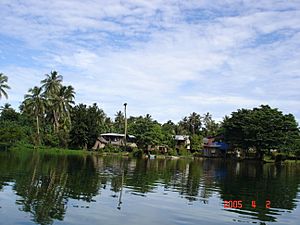
The Solomon Islands is an island nation east of Papua New Guinea. It includes many islands like Choiseul, the Shortland Islands, New Georgia Islands, and Guadalcanal. The islands stretch about 1,500 kilometers (930 miles) from west to east. The Santa Cruz Islands are quite far from the others, located north of Vanuatu.
Climate and Weather
The islands have a very humid climate all year round. The average temperature is about 26.5°C (80°F). There are not many extreme changes in temperature or weather. June to August is usually a bit cooler. From November to April, northwesterly winds bring more rain. Sometimes there are strong storms or cyclones. The islands get about 3,050 millimeters (120 inches) of rain each year.
Plants and Animals
The Solomon Islands are home to two special forest areas. Most islands have Solomon Islands rain forests. These forests are important but are affected by logging. The Santa Cruz Islands have Vanuatu rain forests.
The soil varies a lot, from very rich volcanic soil to less fertile limestone. Over 230 types of orchids and other tropical flowers grow here. There are not many mammals, mostly bats and small rodents. But there are many birds and reptiles.
The islands have several active and dormant volcanoes. The Tinakula and Kavachi volcanoes are the most active ones.
Government and Leadership
The Solomon Islands is a constitutional monarchy with a parliamentary system of government. This means King Charles III is the head of state. He is represented by a Governor-General. The Governor-General is chosen by the Parliament for a five-year term.
The country has a single parliament with 50 members. These members are elected for four-year terms. Citizens over 21 years old can vote. The head of government is the Prime Minister. The Prime Minister is elected by Parliament and chooses the cabinet.
The Solomon Islands does not have its own military forces. However, it has a police force of almost 500 people. This police force also handles border protection, fire services, and disaster relief. They also watch over the seas around the islands.
Economy and Resources
The Solomon Islands is a developing nation. More than 75% of its workers are involved in farming and fishing to feed their families. Most manufactured goods and oil products are brought in from other countries. Only about 3.9% of the land is used for farming. However, 78.1% of the islands are covered by forests. This makes the Solomon Islands one of the most forested countries in the world.
Exports and Trade
Timber used to be the main export until 1998. At that time, world prices for tropical timber dropped. Also, the forests were being cut down too quickly. After some ethnic violence in 2000, exports of palm oil and gold stopped. Timber exports also decreased.
Recently, the Solomon Islands has allowed the export of live dolphins. This practice has received criticism from other countries and environmental groups.
Farming and Crops
Other important crops for export include copra (dried coconut meat), cacao (for chocolate), and palm oil. In 2017, the country produced a lot of coconuts, making it the 18th largest producer worldwide. Copra made up 24% of exports. Cocoa beans are grown mainly on Guadalcanal, Makira, and Malaita islands. The Solomon Islands is the 27th largest producer of cocoa worldwide.
However, the production of copra and cacao is limited because many coconut and cacao trees are old. The islands also produce a lot of palm oil. Farming here is difficult because there are not enough agricultural machines. For local use, families grow taro, rice, yams, and bananas. Tobacco and spices are also grown for the local market.
Mining and Minerals
Gold mining started in 1998 at Gold Ridge on Guadalcanal. The islands have many untapped mineral resources. These include lead, zinc, nickel, and gold. There are talks about reopening the Gold Ridge mine, which closed after riots in 2006.
Fishing Industry
The fishing industry also has potential for exports and local growth. A Japanese company that ran the only fish cannery closed in 2000 due to unrest. The plant has reopened under local management, but tuna exports have not fully restarted.
Tourism and Visitors
Tourism, especially diving, could become a big industry for the Solomon Islands. However, there are not enough hotels or good transportation. In 2017, only 26,000 tourists visited the islands. This makes it one of the least visited countries. The government hopes to increase tourist numbers in the coming years.
Currency and Money
The Solomon Islands dollar (SBD) is the local money. It was introduced in 1977. Its symbol is "SI$". One dollar is divided into 100 cents. In some parts of the country, especially remote areas, traditional shell money is still used for ceremonies and trade. Shell money is often made in Malaita and Guadalcanal. Sometimes, people in remote areas trade goods directly instead of using money.
Infrastructure and Travel
Flight Connections
Solomon Airlines connects Honiara to cities like Nadi in Fiji, Port Vila in Vanuatu, and Brisbane in Australia. It also flies to over 20 airports within the country. To help tourism, Solomon Airlines started a direct flight between Brisbane and Munda in 2019. Virgin Australia also flies to Honiara from Brisbane twice a week. Most local airports are small with grass runways, only suitable for small planes.
Roads and Transport
The road system in the Solomon Islands is not very developed. There are no railways. The most important roads connect Honiara to Lambi (58 km) and Aola (75 km) on Guadalcanal. There are few buses, and they do not follow a fixed schedule. In Honiara, the main bus stop is in front of the Central Market.
Ferries and Boats
Most of the islands can be reached by ferry from Honiara. There is a daily high-speed catamaran service from Honiara to Auki, stopping in Tulagi.
People and Culture
| Population | |||
|---|---|---|---|
| Year | Million | ||
| 1950 | 0.09 | ||
| 2000 | 0.4 | ||
| 2018 | 0.7 | ||
As of 2018[update], there were 652,857 people living in the Solomon Islands.
Ethnic Groups
| Ethnic Groups in The Solomon Islands | ||||
|---|---|---|---|---|
| Ethnic Groups | percent | |||
| Melanesian | 95.3% | |||
| Polynesian | 3.1% | |||
| Micronesian | 1.2% | |||
| Chinese | 0.1% | |||
| European | 0.1% | |||
| Other | 0.1% | |||
Most people in the Solomon Islands are Melanesian (95.3%). Other important groups are Polynesian (3.1%) and Micronesian (1.2%). There are also a few thousand Chinese people.
Languages Spoken
English is the official language, but only a small number of people speak it fluently. However, a local English-based language called Solomons Pijin is widely spoken. Most people use Pijin along with their local tribal languages. Pijin is similar to Tok Pisin spoken in Papua New Guinea.
There are 74 local languages listed for the Solomon Islands. Most of these are Melanesian languages. Polynesian languages are spoken on islands like Rennell, Bellona, and Tikopia. People who have moved from Kiribati speak a Micronesian language.
Religion and Beliefs
Most people in the Solomon Islands are Christian (about 92%). The main Christian groups include the Anglican Church of the Province of Melanesia (35%), Roman Catholic (19%), and the South Seas Evangelical Church (17%). Other groups are the United Church in Papua New Guinea and the Solomon Islands (11%) and Seventh-day Adventist (10%).
About 5% of the population follows traditional local beliefs. A small number of people follow Islam or the Baha'i Faith.
Education for Children
Education is not required by law in the Solomon Islands. Only about 60% of school-aged children go to primary school. There are kindergartens, even in the capital, but they are not free.
The number of children going to primary school increased from 1990 to 1994. However, there have been challenges like a lack of government money and problems with teacher training. The government is working to improve schools and increase enrollment. In 2015, about 84.1% of adults could read and write.
Culture and Arts
The culture of Solomon Islands is very diverse. Different groups live on different islands, speaking various languages. This diversity is seen in their unique arts and crafts. The cultural area includes the country itself and Bougainville Island, which is part of Papua New Guinea.
Some societies in the Solomon Islands have Polynesian traditions. These are called Polynesian outliers. They include islands like Anuta, Bellona, and Tikopia.
Solomon Islands arts and crafts include many woven items and carved objects. They make things from wood, stone, and shells. Each province has its own special styles.
Food and Cuisine
The cuisine of Solomon Islands has been shaped over thousands of years. Spanish explorers brought cattle to the islands. Asian and Indian influences added spices, vegetables, and fruits. Later, the English also left their mark on the food.
Most local people are involved in fishing and farming. So, fish, coconuts, cassava, sweet potatoes, and many fruits and vegetables are common. Cooking methods include baking, boiling, and frying. Fish is a main source of meat. It is usually cooked and served with sweet potatoes, rice, taro roots, and other vegetables. You can also find European and Asian dishes in restaurants and homes.
Some special dishes of the Solomon Islands include:
- Ulu (breadfruit): This can be served with any meal.
- Bananas and other exotic fruits: Sometimes wrapped in pearl cassava and served with whipped cream or caramel.
- Poi: Made from fermented taro roots. It is served during celebrations. Poi can be served with chicken or fish, or made like a porridge. Tapioca or pearl cassava, often served like a pudding, is also common during holidays.
Images for kids
-
American Marines resting during the 1942 Guadalcanal Campaign.
See also
 In Spanish: Islas Salomón para niños
In Spanish: Islas Salomón para niños





